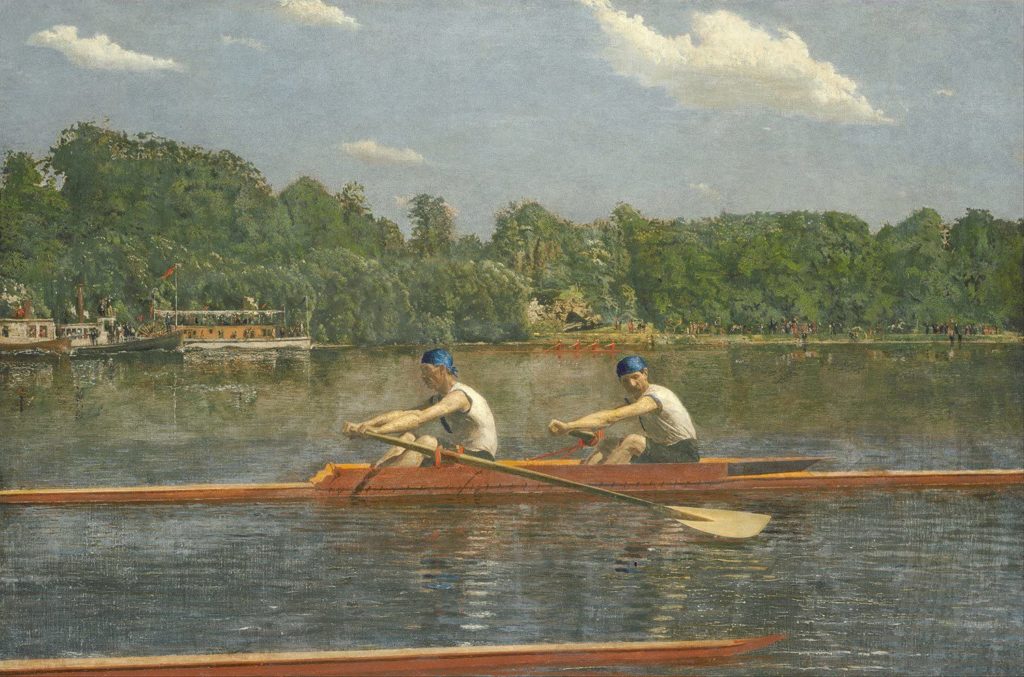Sculls that are sawed in half overnight. Rowers who abruptly stop mid-course during a race to smile and wave, assured of their win — or assuring their loss. A sudden illness and an excuse not to compete.
Such were the gambits of professional rowers during the late 19th century, when men who rowed for money could earn as much in just one race as a working man could bring home in an entire year. Sometimes, maybe even often, they didn’t win that money fair and square.
In a new book, The Triumph of Amateurs, writer William Lanouette captures the excitement and corruption of professional rowing, which stretched from the second half of the 19th century into the early 20th. By then, public disgust at races being thrown curtailed the large purses, leading many of these rowing celebrities to transform themselves into reputable college coaches.
Digging exhaustively into publications of the era, Lanouette writes in detail about race after race (his bibliography is 14 pages long). Story after story of suspicious outcomes leave the reader with the same cynicism about professional rowing that led the New York Times in 1887 to write, “Are all these professional oarsmen only so many puppets..[.who] generally obey the instructions of the gamblers who manage them and who lay plans for deceiving and fleecing simple-minded outsiders…? The people are fond of humbug and they are willing to pay for it.”
Among the men Lanuouette profiles is Charles Courtney, who often falls ill before a race and pulls out. Or has an odd accident, like having his oar hit an underwater wire that no one can later find. Was he paid to do so? With so much money sloshing about in purses and the bets made by tens of thousands of spectators, it’s not surprising that greed determined the outcomes perhaps as often as speed and finesse.
For instance in 1878, New Yorker Courtney races against the Canadian Ed Hanlan — who two years earlier, as an amateur, won the sculling race at the International Regatta that took place at Philadelphia’s Centennial Celebration. The five-mile race in Montreal was seen as a proxy match between the U.S. and Canada, with a $6,000 purse (about $140,000 in today’s money). “Nearing the finish, they were even when across the course drifted wooden barges. Courtney stopped, then pulled on while Hanlan darted around them” and won. Quoting an Ithaca newspaper, Lanuouette writes, “‘The general belief here is that Courtney sold yesterday’s race,’ citing as evidence his erratic steering and low stroke rate.”
The next year, the two were to race again on New York’s Lake Chautauqua. That morning, Courtney wakes up to discover that his custom-made boat has been sawed in half. Courtney accuses Hanlan. Hanlan claims Courtney did it himself.

As early as 1858, the amateur rowing clubs of Philadelphia, through their administrative group, the Schuylkill Navy, launched the country’s fight against professional rowing by issuing the first amateur rules for any sporting organization in the United States. But Lanouette gives that momentous decision just one sentence in his book and largely ignores the influence of Philadelphia on the rise of amateur rowing.
He does, however, talk about the relationship of another pair of professional rowers, the Biglin Brothers, to the Philadelphia painter Thomas Eakins. Eakins, who sought to capture moments of movement on canvas, was intrigued by the skill and musculature of these champions as well as the challenge of placing them with exacting perspective on the Schuylkill River in late afternoon. Why Lanouette (or his editors) decided to place the chapter on Eakins and the Biglins as an appendix rather than an integral part of the book is a mystery to me. The well-researched details on Eakins’ interest in the Biglins and his artistry would have made for a welcome break for the reader from chapter after chapter on the professional rowers’ shenanigans.
After all, Eakins’ many rowing paintings of the 1870s are about all that are left to remind us today of an era when rowing was the most popular spectator sport in this country, with all the excitement (and betting) of March Madness today.
